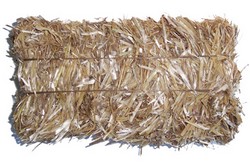 Hay bales are a food source. That is the first and perhaps most important difference. Hay is actually a plant that is cut when it is alive and full of grain. The purpose of the hay is to feed animals.
Hay bales are a food source. That is the first and perhaps most important difference. Hay is actually a plant that is cut when it is alive and full of grain. The purpose of the hay is to feed animals.
Straw, on the other hand, is simply the stalks of standing plants that contain no grain. The grain is harvested from the plants by a machine that cuts it off of the stalk. The grain is then removed from the field and the stalks are left to die, standing. Once they are totally dead and mostly devoid of moisture, they are cut, raked, and baled. The baled straw has multiple uses. It can be used as animal bedding, erosion control, home building, and more. One thing it is not used for is food.
Thanks KLAW

Dag nab it!! I can’t remember which is which! Straw is for straw, and hay is for eating, and I can tell you which is a bale of which, but my memory can’t remember the difference.
It’s easy to tell the difference. Put some hay and some straw in front of a horse. The pile that he eats is the hay.
Well, hay isn’t actually a ‘plant’ per se. Hay doesn’t have a ‘grain.’ Hay is typically fescue, alfafa, or other orchard grasses that are mowed, field-dried, raked, and then baled. If you don’t let it dry sufficiently, it can mold in the bale and/or it can build up heat and spontaneously start a fire (I’ve never personally known of a wet-hay induced fire, but my grandfather mentioned it and if you put your hand inside a wet bale, you can feel the heat building up).
The explanation it not totally correct. Straw is usually not used as a feed source, however, it can be mixed with a high protein food source to bring up the fibre content in a feed ration. Straw is usually yellow and made up of long, hollow stems (kind of looks like a drinking straw). Good quality hay is usually green, but can sometimes turn brown if it gets rained on too often before baling.
Chris – just think that straw is for sleeping; that should help. Also, hay is usually green (unless it is old) and straw is not–it is more tan.
revrick315 – is clover considered a plant or an orchard grass? My father-in-law has hay fields of mixed alfalfa and clover for his cows.
And do not forget that animals eat different types of hay depending on their dietary needs. For instance, while a cow may need alfalfa or clover hay, a horse needs timothy hay (if I remember correctly).
Hay is not necessarily green. Oat hay is kinda of a light color, similar to wheat straw. And horses love alfalfa, but it can make them sick. I stick to oat and coastal bermuda hays.
Straw is used as a food source particularly in dairy cattle, it makes the animal feel full and content
Well, Tim, I’m probably not the definitive hay expert around, but both timothy and clover, as well as alfafa, were considered prime cut for hay when I was pitching bales around. The comment I made about it not being a ‘plant per se’ meant that you wouldn’t go into a Tractor Supply or Co-op and say you wanted to buy a ‘Hay plant’ the way you might a Rose bush, you’d buy seeds for the particular type of grass/feed you wanted to grow.
We cut and baled whatever was growing in the fields, and the cows and ponies liked that hay just fine. Baling hay was some good times. I had such bad hay fever as a kid, but it didn’t matter for those few days every year. Sitting on top of all those bales on the trailer with the tractor putt-putting along, watching the big guys throw the bales so high when I could barely pick one up at all… so much fun. Now they make those stupid huge round bales, what’s the fun in that?
Scott – you only cut hay once a year? My father-in-law cuts and bales about 3 times a year.
Straw is what you drink your margarita through, hay is what you say to your buddy when he walks in the bar.
Hay is for horses, straw is for cows, milk is for babies to shut up their mouths.
I think we usually did once a year for ourselves. It was enough to fill the barn to use all winter. Maybe another farmer came and took some for himself some years, I don’t remember. I know he used some of our land for growing other stuff sometimes. Whatever happened didn’t matter to me, but farm life as a kid was great.